DonNichols
Atmos Energy Corporation (NYSE:ATO) is one of the largest natural gas utilities in the United States, serving customers in eight states. The company also has a midstream natural gas infrastructure unit, which is not exactly uncommon among the larger natural gas utilities. The utility sector in general has long been popular with conservative investors that are looking for income due to the companies’ stable cash flows and high dividend yields. Over the past few years, though, natural gas utilities have lost some of their shine in the market compared to their electric peers, which is likely due to all the talk about electrification.
As we will see later in this article, though, there is no particular reason to believe that natural gas utilities will become obsolete anytime soon, so the current beliefs allow us to pick up shares of many of these companies at very attractive valuations. This is certainly true with Atmos Energy, as the company’s valuation is quite attractive but unfortunately, it does not have as high a yield as we might prefer. I have discussed this company in the past and while that thesis still remains valid, it is important that we revisit the company as five months have passed so a few things have changed. Overall though, Atmos Energy remains a very solid addition to the portfolio of any conservative dividend investor.
About Atmos Energy
As stated in the introduction, Atmos Energy Corporation is one of the largest natural gas utilities in the United States. The company serves over three million different customers in eight different states:
Atmos Energy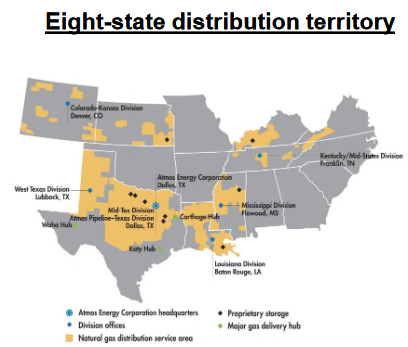
As I have pointed out in numerous previous articles, however, the size of a utility has little impact on its investment potential. This is because a large utility like Atmos Energy still has many of the same characteristics as a much smaller peer. One of the most important of these characteristics is that it enjoys generally stable cash flows. We can see this quite clearly by looking at the company’s operating cash flows over a given trailing twelve-month period. Here they are for every quarter going back to March 2020:
As we can see, with the exception of 2021, the company’s operating cash flows were generally pretty similar during any given twelve-month period. The reason for this is that the service that the company provides is generally considered to be a necessity. After all, if your house has natural gas for heating or cooking, then you will generally prioritize paying your natural gas bill above most discretionary expenses during times when money gets tight. This is something that could be quite important today as the rising prices for food and energy have strained the budgets of many households.
I have pointed this out in numerous recent articles. The fact that the company had negative operating cash flows in 2021 is no exception to this stable cash flows rule, as that was caused by Winter Storm Uri in February 2021, which spiked natural gas prices all across Texas. That was a one-off event and is something that is unlikely to occur again in our lifetimes. If we remove the impact of this storm from the company’s results, its operating cash flows would have been pretty similar the whole way back to March 2020.
As investors, we are not likely to be satisfied with mere stability. We like to see growth. Fortunately, Atmos Energy Corporation is well-positioned to deliver growth going forward. The primary way that it is going to do this is by growing its rate base. The rate base is the value of the company’s assets upon which regulators allow it to generate a specified rate of return, which is a 9.8% blended allowed rate of return across Atmos Energy’s service territory. As this rate of return is a percentage, any increase in the rate base allows Atmos Energy to increase the prices that it charges its customers in order to earn that specified rate of return.
The usual way for the company to increase its rate base is by investing money into upgrading, modernizing, and possibly even expanding its natural gas infrastructure. Atmos Energy Corporation is currently planning to invest $13 billion to $14 billion over the 2022 to 2026 period toward this objective. This should have the effect of increasing its rate base from the $12.1 billion that it had at the start of the year to $21.0 billion to $23.0 billion by year-end 2026:
Atmos Energy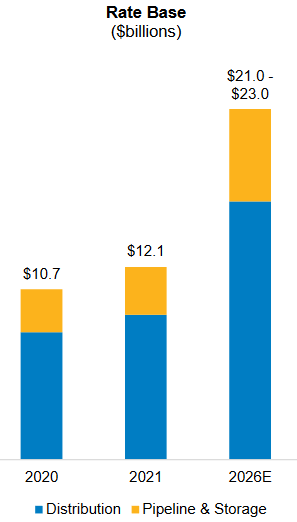
At this point, some readers will point out that the company is investing far more than the value of its rate base increase. This is certainly true and it is also not unusual. One of the causes of this is depreciation. In short, the value of the company’s assets is decreasing fairly rapidly. As a result, an asset that it puts into service in 2023 will have a much lower value in 2026, so the company needs to invest money every year just to keep its rate base steady. In order to produce growth, it needs to invest enough to overcome the declining asset values caused by depreciation and still increase the size of its rate base. Despite the fact that its rate base will not increase dollar-for-dollar with its capital expenditures, the company should still be able to increase its earnings per share at a 6% to 8% rate over the period. When we combine this with its current 2.61% dividend yield, the company should be able to deliver a 9% to 11% total annual return over the period. This is certainly not a bad total return for a slow-growth utility stock.
The growth that the company will deliver over the next few years will be a continuation of its long-term trend. Atmos Energy has successfully increased its earnings per share during each of the past nineteen years. Indeed, during the most recent quarter, Atmos Energy reported total revenue of $722.6 million and earnings per share of $0.51. These both represent increases over the $568.4 million revenue and $0.37 per share earnings that it had in the prior-year quarter. These improved revenue and earnings figures were accompanied by a dividend increase, which we will discuss later in this article.
As stated in the introduction, Atmos Energy is more than just a regulated natural gas utility. The company also owns a network of pipelines spanning the state of Texas:
Atmos Energy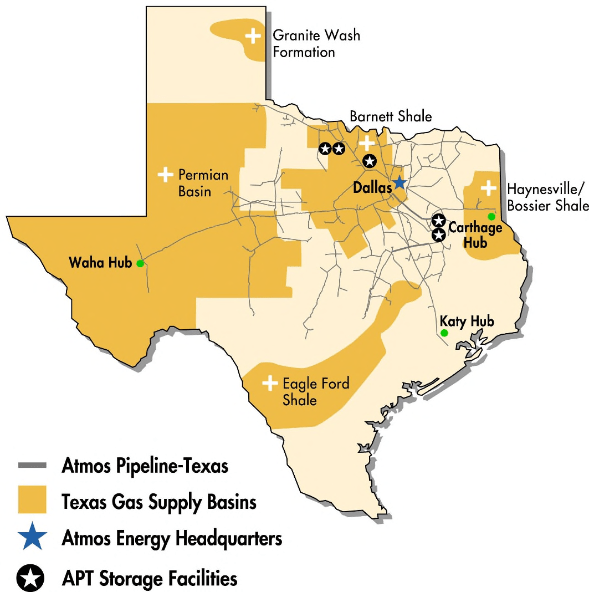
In total, Atmos Energy owns 5,700 miles of pipelines that serve to transport natural gas all around the state of Texas. As we can see, the company has a presence in the Permian Basin, the Barnett Shale, and the Haynesville/Bossier Shale. This is nice to see because all three of these are some of the major natural gas-producing basins in the United States. In fact, the Haynesville Shale and the Permian Basin also have some of the largest natural gas reserves in the country (only Appalachia is higher). These pipelines do not serve end customers as the company’s utility operation does, however. Rather, these pipelines are intended to transport natural gas from the basins to Mid-Tex (one of Atmos Energy’s natural gas utilities) and other utility companies throughout Texas.
The company’s pipeline network operation generally enjoys the same cash flow stability that we expect from Atmos Energy’s other operations. This is due to the business model that it uses. In short, Atmos Energy enters into long-term contracts with upstream energy companies or other customers that need natural gas, such as local utility companies. The company transports this natural gas through its pipelines and is compensated by the customers based on the volume of resources handled, not their values. This provides the overall operation with a great deal of protection against resource price fluctuations. Despite the presence of this business, Atmos Energy should still be thought of as a utility company since it derives 68% of its net income from its utility businesses.
Fundamentals For Gas Utilities
As stated in the introduction, natural gas utilities are somewhat unpopular compared to electric utilities. This is evident in their valuations as most of these utilities are considerably cheaper relative to their earnings than electric utilities. The biggest reason for this would seem to be electrification, which has been widely promoted by activists, futurists, and politicians. At its core, electrification refers to the conversion of things that are historically powered by fossil fuels to the use of electricity instead. One of the most commonly cited things to be converted is space heating, which is of course the primary use of natural gas. Thus, the concern is that electrification will make natural gas utilities obsolete in the near future.
However, it is highly likely that this concept has been over-promoted in the media. According to the Energy Information Administration, the national demand for electricity will only grow at a 1% to 2% rate over the next thirty years:
EIA Annual Energy Outlook 2022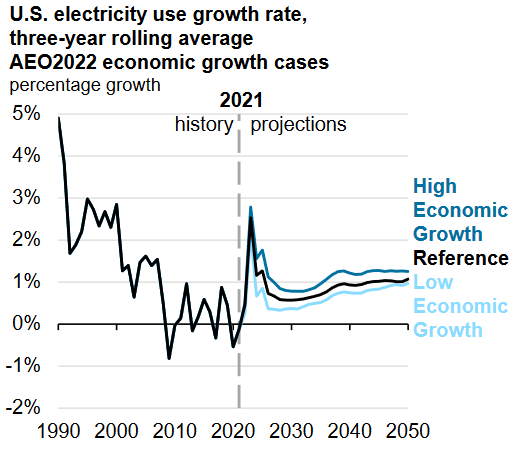
This is nowhere close to the growth rate that we would expect if wide swathes of the economy were converted from fossil fuels to electricity. In fact, it is considerably lower than the consumption growth that we saw in the late 1990s when the Internet was just starting to become a thing. Thus, the agency considers it unlikely that we will be seeing a significant percentage of American households converting their heating systems from natural gas to electricity. It is likely that the agency is correct here as natural gas is substantially more efficient at producing heat than electricity. This is immediately evident when we look at fuel costs. The agency points out that it can be nearly four times as expensive to heat a house with electricity as opposed to natural gas:
New Jersey Resources/Data from EIA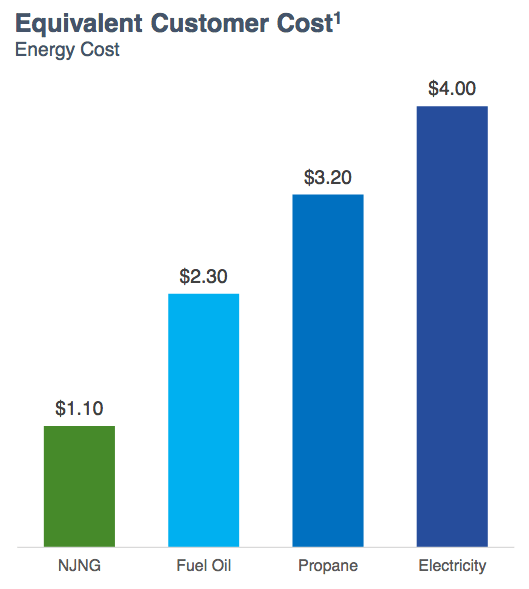
This is true despite the fact that natural gas prices have increased over the past year. It seems rather unlikely that very many people will willingly convert their homes from natural gas to electricity and pay higher costs just to reduce their carbon emissions. This is particularly true among those of limited means. Thus, it seems likely that the products provided by Atmos Energy will remain in demand for a very long time. Investors certainly do not have to worry about this company becoming obsolete in the near future.
Financial Considerations
It is always critical that we examine the way that a company finances itself before making an investment in it. This is because debt is a riskier way to finance a company than equity because debt must be repaid at maturity. As this is usually accomplished by issuing new debt to repay the maturing debt, a company’s interest costs may increase following the refinancing depending on the conditions in the market. In addition to this, a company must make regular payments on its debt if it is to remain solvent. As such, an event that causes a firm’s cash flows to decline may push it into financial distress if it has too much debt. Although utilities such as Atmos Energy tend to enjoy remarkably stable cash flows, this is still a risk that we should consider before making an investment.
One metric that we can use to judge the financial structure of a company is the net debt-to-equity ratio. This ratio tells us the degree to which a company is financing its operations with debt as opposed to wholly-owned funds. It also tells us how well a company’s equity will cover its debt obligations in the event of bankruptcy or liquidation, which is arguably more important.
As of September 30, 2022, Atmos Energy had a net debt of $8.3185 billion compared to $9.4191 billion of shareholders’ equity. This gives the company a net debt-to-equity ratio of 0.88 today. This is an unfortunate increase over the 0.81 ratio that the company had the last time we looked at it, but it is still a reasonably impressive ratio for a utility. After all, most utility companies have a net debt-to-equity ratio over 1.0. Here is how Atmos Energy compares to its peers in this respect:
|
Company |
Net Debt-to-Equity |
|
Atmos Energy |
0.81 |
|
NiSource, Inc. (NI) |
1.44 |
|
South Jersey Industries (SJI) |
1.82 |
|
New Jersey Resources (NJR) |
1.72 |
|
Southwest Gas Holdings (SWX) |
1.73 |
|
Northwest Natural Holdings (NWN) |
1.29 |
As we can clearly see, Atmos Energy is considerably less levered than many other pure-play natural gas utilities. It is also the only company on the list that has sufficient equity to completely pay off its debt obligations in a worst-case scenario. This is certainly a good situation to be in, as it indicates that investors should have no particular concerns about the company’s leverage. Overall, Atmos Energy is in a very strong position here.
Dividend Analysis
As stated earlier, one of the biggest reasons why investors purchase shares of utility companies is because they tend to have fairly high dividend yields. Atmos Energy is certainly no exception to this, as the company has a 2.61% yield at the current stock price. Atmos Energy has increased its dividend every year for the past 37 years, a trait that it continued in the most recent quarter:
This is something that is quite nice to see during inflationary periods, such as the one that we are in today. This is because inflation is constantly reducing the number of goods or services that can be purchased with the dividend that the company pays out. This can make investors feel as though they are getting poorer and poorer with the passage of time. The fact that Atmos Energy increases the amount of money that it pays every year helps to offset this effect and maintain the purchasing power of the company’s dividend. As is always the case though, it is critical that we ensure that the company can actually afford its dividend. After all, we do not want to find ourselves holders of the stock when the company is forced to reverse course and cut its payout since that would both reduce our income and almost certainly cause the share price to decline.
The usual way that we judge a company’s ability to afford its dividend is by looking at its free cash flow. A company’s free cash flow is the amount of money that was generated by its ordinary operations and is left over after it pays all of its bills and makes all necessary capital expenditures. In the twelve-month period that ended September 30, 2022, Atmos Energy had a negative free cash flow of $1.5411 billion. This is clearly not enough to pay any dividend but the company still paid out $375.9 million during the period. At first glance, this is likely to be somewhat concerning.
However, it is not unusual for a utility to finance its capital expenditures through the issuance of equity and especially debt. It will then pay its dividend out of operating cash flow. This is due to the incredibly high costs associated with constructing and maintaining utility-grade infrastructure over a wide geographic area. In the most recent twelve-month period, Atmos Energy reported an operating cash flow of $977.6 million. This is obviously more than enough to cover the $375.9 million that the company actually paid out in dividends with a large amount of money left over. This dividend overall appears to be reasonably sustainable. We should not really have to worry much about a dividend cut here.
Valuation
It is always critical that we do not overpay for any asset in our portfolios. This is because overpaying for any asset is a surefire way to generate a suboptimal return on that asset. In the case of a utility company like Atmos Energy, one way to value it is by looking at the price-to-earnings growth ratio. This is a modified form of the familiar price-to-earnings ratio that takes a company’s forward earnings per share growth into account. A price-to-earnings growth ratio of less than 1.0 is a sign that the company may be undervalued at the current stock price and vice versa. However, there are very few companies that have such a low ratio in today’s overheated market environment. This is particularly true in the low-growth utility sector. As such, it makes the most sense for us to compare Atmos Energy to its peers in order to determine which company offers the most attractive relative valuation.
According to Zacks Investment Research, Atmos Energy will increase its earnings per share at a 7.48% rate over the next three to five years. This is right in the range that we used earlier to calculate our projected annual return so it is probably a fairly accurate estimate. This would give the company a price-to-earnings growth ratio of 2.54 at the current price. Here is how that compares to the company’s peers:
|
Company |
PEG Ratio |
|
Atmos Energy |
2.54 |
|
NiSource, Inc. |
2.74 |
|
South Jersey Industries |
N/A |
|
New Jersey Resources |
3.28 |
|
Southwest Gas Holdings |
3.83 |
|
Northwest Natural Holdings |
4.28 |
As we can clearly see here, Atmos Energy has the most attractive ratio here. What is more, the company’s ratio is quite a bit lower than when we looked at it over the summer. The company thus appears to be offering a very attractive value proposition relative to its peers. This is obviously quite nice to see today and could point to an investment opportunity.
Conclusion
In conclusion, Atmos Energy appears to have a lot to offer to a conservative utility investor. Chiefly, the company has a stronger balance sheet than most of its peers, a respectable and sustainable dividend yield, and an attractive valuation. The company also offers sufficient growth potential to satisfy most market participants. All in all, Atmos Energy looks like a solid addition to a portfolio today.



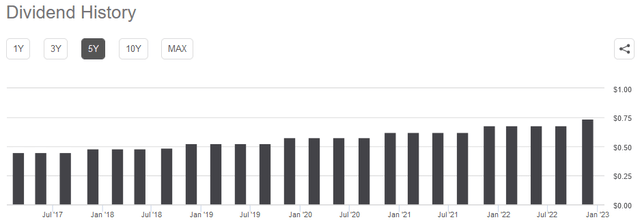
Be the first to comment